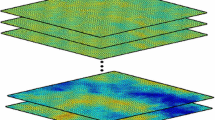Abstract
This paper discusses issues related to the choice of total or effective porosity as the porosity basis for geostatistical model construction. Distributions of variables are different depending on the porosity basis. The distribution of variables has a strong effect on the performance of collo-cated simulation techniques. This paper presents the two porosity approaches and demonstrates some of the issues that may arise. In the examples shown here, total porosity appears to generate better behaved porosity-permeability co-distributions. Regardless of the porosity basis, upscaling methods are shown to potentially move hydrocarbon from low quality rock into more accessible coarser cells which means that any application of cutoffs is more meaningfully applied prior to upscaling if this movement is considered unrealistic for large-scale flow simulation.
Similar content being viewed by others
References
Deakin, M. J. W.: 1990, Integrating petrophysical data: established and emerging techniques; OGCI course notes, OGCI Houston, 1999.
Deakin, M. J. W. and Manan, W.: 1998, The integration of petrophysical data for the evaluation of low contrast pay, In: SPE 39761, Kuala Lumpur SPE Conference, March, 1998.
Deutsch, C. V. and Journel, A. G.: 1998, GSLIB: Geostatistical Software Library, Oxford University Press.
Dodge, W. S., Shafer, J. L. and Klimentidis, R. E.: 1996, Capillary pressure: the key to producible porosity, In: SPWLA Annual Logging Symposium, June 16–19, 1996.
Durlofsky, L. J., Jones, R. C. and Milliken, W. J.: 1994, A new method for the scale up of displacement processes in heterogeneous reservoirs, In: Proc. 4th European Conf. On the Mathematics of Oil Recovery, Roros, Norway, June 1994.
Ekrann, S.: Saturation modeling: an upscaling point of view, 1999 SPE 56559, Ann. Tech. Conf. Houston, 3–6 October, 1999.
Flolo, L. H.: 1998, Getting the hydrocarbon volumes right – a quantitative use of NMR data in water saturation modeling, In: SPWLA 39th Ann. Logging Symposium. 26–29, May 1998.
Goovaerts, P.: 1997, Geostatistics for Natural Resources Evaluation, Oxford University Press, New York, 483pp.
Journel, A. G.: Conditioning Geostatistical Operations to Nonlinear Volume.
Juhasz, I.: 1988, Porosity systems and petrophysical models used in formation evaluation, In: SPWLA London Chapter Porosity Seminar, 26th April, 1988.
Mincom.: 1997, Geolog Multimin Technical Reference, Mincom Pty Ltd, Brisbane, Australia.
Pallatt, N. and Thornley, D.: 1990, The role of bound water and capillary water in the evaluation of porosity in rerservoir rocks. In: P. Worthington (ed.), Advances in Core Evaluation, Gordon and Breach.
Prammer, M. G., Drack, E. D., Gardner, J. S., Coates, G. R., Chandler, R. N. and Miller, M. N.: 1996, Measurements of clay bound water and total porosity by magnetic resonance logging, In: SPE 36522 Ann. Tech Conf. Denver, 6–9 October, 1996.
Worthington, P. F.: 1991, Effective integration of core and log data, In: paper SCA 9102 presented at the 1991 SCA Annual Technical Conference, San Antonio, 21–22 August.
Author information
Authors and Affiliations
Rights and permissions
About this article
Cite this article
Taggart, I. Effective versus Total Porosity Based Geostatistical Models: Implications for Upscaling and Flow Simulation. Transport in Porous Media 46, 251–268 (2002). https://doi.org/10.1023/A:1015052712760
Issue Date:
DOI: https://doi.org/10.1023/A:1015052712760




